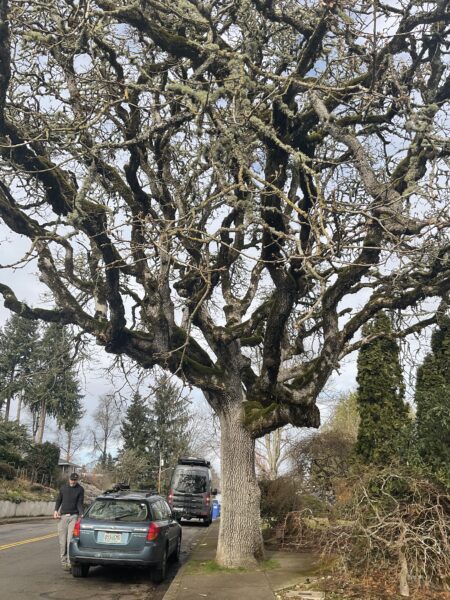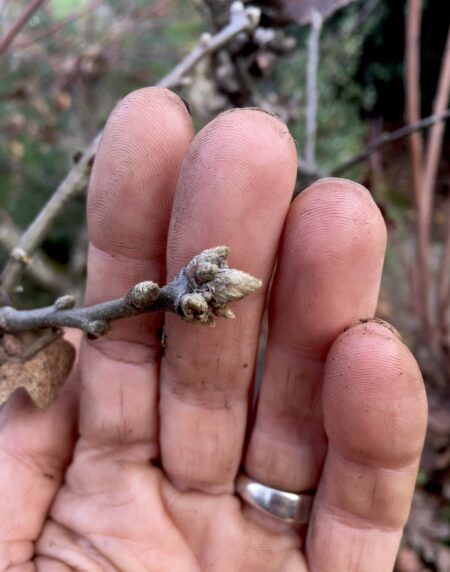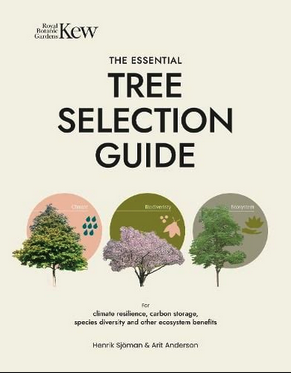To You, Street Trees
March 19, 2024
Curbed in
concrete and asphalt,
rooted beneath impermeable
surfaces of human engineering,
yet still,
you tower,
you arch overhead,
tickling third-story windows,
holding nests
and sunlight
in your crowns.
Thank you.
Thank you street trees
for the visual rest of your complexity
in a straight-lined urbanity.
Your branches trace dark lines,
earth’s signature,
on gray winter sky,
laying fleeting shadows across my face,
greening hope with
spring’s lengthening days,
tempering summer’s hottest heat,
capturing dust and smoke and industrial crap
in the generosity of your vast foliar surface area.
Thank you for cooling, for cleaning,
for drawing down what we belch and burn.
Thank you for growing.

To the wide-branching octopus arms of
Oregon White Oak atop College Hill on Lincoln street;
and, to the Catalpa on University street,
blowing tropical trusses into the phone-sucked
faces of college kids;
and, to the tunnel of green on Jefferson,
Linden, Maple, Horsechestnut,
under you,
autopilot driving becomes a chance to breathe,
in and out;
and to the downtown heritage Big Leaf Maples,
sidewalks curve and lift to make room for your boles,
your elephantine girth;
to you, all you big, old street trees,
I bow.

And,
to the young ones,
the Oak sapling I planted
on my lucky 43rd birthday,
inching up and out,
barely taller now than my truck
parked nearby;
and to the Golden Raintree
stick of potential on 1st,
may you be safe from lashing
impulses of the mentally unwell;
and to all the children of Friends of Trees,
lovingly staked, labeled, and mulched;
to you, all you hopeful youth,
woods of the future,
I bow.
City living,
rich in culture,
accessible in concrete,
climate in crisis,
is whole only in the presence of
good, healthy generations of trees.

Trees of the Future
Recently I heard the charmingly accented lecture of Swedish author, horticulturist, and tree researcher Henrik Sjöman. He quoted, of all people, Mike Tyson, who once said “Everybody has a plan until they get punched in the face.”
The “plan” of an individual tree is coded in its genes, inherited from the evolutionary adaptations of its ancestors. What options does the tree have to adapt to whatever the seasons throw at it? Will it drop leaves to protect itself from water loss in a drought or does it have the cellular ability to withstand less and less water delivered to its leaves from its roots?
Katsura (Cercidiphyllum japonicum), found in the wild along stream banks, never needed to evolve adaptations to drought. As a street tree, we see Katsuras drop their leaves earlier and earlier, and, during the heat dome of 2021, many died. But, other trees like Golden Raintree (Koeltreuteria paniculata) have been prepared over generations of evolution in a drier habitat to withstand long periods without rainfall.
Why does all this matter? As Henrik reminds us, when you shop for a car or a new computer, you do your research. You want to make sure the investment will last a long time, that it will function the way you want, that it won’t require too much maintenance. Taking the same approach to choosing your garden trees, especially in the extreme microclimates alongside streets, is often bypassed. You’re swayed by the beauty of Katsura’s heart shaped leaves, or the memory of your grandmother’s flowering cherry and stop there, asking no further questions.
Paying attention to your lived experiences of climate extremes impresses on you the need to expand beyond gardening for aesthetics alone. Now, you seek beauty and fitness. What’s more beautiful than resilience in the long run?
If the “plan” of the tree is encoded in its genes, then the “punches” come in the form of drought, heat, flooding, ice storms, and fire. You don’t know exactly what punches are coming, but patterns of extremes on both ends are evident—hotter, drier summers, and wetter, colder winters. What trees can we find in our nurseries that evolved in places on earth that match these extremes?
The tricky part is in parsing out the mixed information from authors and online resources. All horticultural experience is local. Anecdotal information about any one tree varies from source to source.
Thankfully, the science of plant explorers has shifted from seeking the novel for collector’s gardens, to the novel for extreme climate adaptations. Even among a single tree species, those sourced from different parts of their native range show measurable variability in their encoded adaptability.
This is good science. The more you ask for it, the more you’ll start to see the information. Do your research. Support the nursery people who are propagating a new generation of trees.
Here’s to the young trees
planted thoughtfully
planted well
well-chosen,
deeply watered.
May their roots grow deep,
may their lives be longer even than
those whose hands packed earth around them,
may they temper the extremes
for our grandchildren’s grandchildren.
May they grow
to shelter wonder,
shelter birds, insects,
shade ground, cool heads
clean air, calm hearts.
Sources:
